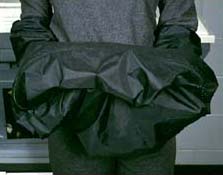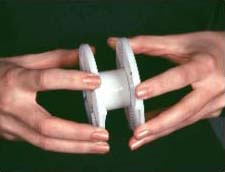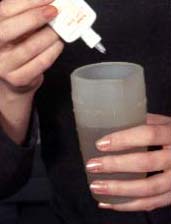Processing Angiograms
|
Janice Clifton, CRA COT |
Paul R. Montague, CRA FOPS |
Photographic Illustrations by |
The equipment used to process film varies greatly with the volume of film to be processed. The equipment outlined here is the minimum needed to process small numbers of angiograms in a private ophthalmology office. Practices which perform twenty to fifty angiograms per day may dedicate large areas to darkroom facilities and may resort to the purchase of sophisticated automated film processing equipment. Here are the basics:
Dark room. "Dark" in this case means very dark. The film is extremely sensitive to light. If you can see anything in the room after being locked inside for fifteen minutes, there is too much light entering the room to safely process film. If a sufficiently dark room is not available, there is an alternative: A changing bag.
 Dark Room |
 Changing Bag |
Changing bag. The changing bag is a very inexpensive substitute for a dark room. Consisting of two black light-proof cloth bags, one inside the other, the film cassette, processing reels, and light-tight processing tank can be placed inside of the bag and the bag zipped shut. The photographer places his/her arms through elastic banded arm holes, and the film can be safely loaded into the processing container in a lighted room.
Reels and tanks. The film is loaded onto a spiral reel and the reel is placed into a small chemical tank for processing. There are two basic types of reels and tanks: Plastic and metal. Which to purchase is mostly a matter of taste. Most photographers prefer one over the other, but there is only a difference in how the reels are loaded and not in the end result. Tanks may be purchased in many sizes from single-reel tanks to those which hold eight or more rolls of film at a time. Reels and tanks are discussed in detail in the next section.
 Metal Reel |
 Plastic Reel |
Rubber gloves. Generally, the kind normally used for house cleaning do nicely. Do not use medical latex exam gloves when handling film! These gloves can be covered with powder that may produce permanent white speckles on the film. The use of gloves when handling developer is highly recommended.
Scissors. Regular household scissors work fine. They will be used to trim the leader off of the film before loading it onto the processing reels.
Can opener. Don’t buy anything fancy! The common metal type with a pointed can opener at one end and a bottle opener at the other are perfect. This will be used to pop the end off of the film cassette. The pointed can-opener end won’t be used so if yours doesn’t have that end, don’t worry.
Containers. These must be chemical resistant and should be dark for storage of developer because the developer ages more quickly in light. Photography stores sell one-gallon containers specifically for this purpose. Don’t use old milk cartons for this purpose. They aren’t dark, they aren’t very strong, and they don’t have screw-on lids to prevent spills.
Funnels. Photo stores sell plastic funnels with wide necks that work very well for pouring chemistry. Do not use a metal funnel because it may react with the chemistry (unless you want to spring for a Type 316 Stainless Steel funnel, of course). Using the same funnel that you use to put oil in your car last week would also be a poor choice here.
Graduates. Not the kind that come out of high school…. Either plastic or glass graduated cylinders in 50ml and 100ml sizes, plus mixing vessels in 500ml (16 ounce), 1000ml (1 quart) and 1 gallon sizes will be useful. The graduates will be used to measure chemistry and the larger containers will be used to mix it.

Plastic Graduate
Stirring rods. Kodak makes yellow stirring rods that are about 12 inches long and have a small 1 inch perforated paddle at the end. They are perfect for mixing chemicals. Buy several of these. You will want to use one only for developers, never placing it in other chemicals.
Thermometer. These are special thermometers. Photo stores sell dial type thermometer made of stainless steel that is easy to read and accurate enough for our purposes. Glass thermometers tend to be more accurate but are more difficult to read and break easily. Do not pick up a thermometer at the local grocery store because it may not be resistant to the chemistry.
Darkroom timer. Don’t skimp here. Buy a Gralab brand darkroom timer. They have a large, 12 inch dial that is easy to set and the dial glows in the dark.
Clothes line and clothes pins. Well, we have to have something to hang the negatives on to dry. The film will not dry evenly on the reels, so after processing is complete, you will need a dust-free area to dry the film. A hair dryer can speed the drying process, but be careful. The best solution, and one that should be seriously considered if more than one or two rolls of film a week are to be processed is a drying cabinet.
Drying cabinet. A substitute for the clothes line, any serious photographer would consider this an absolute necessity. Photo stores sell many varieties.
|
